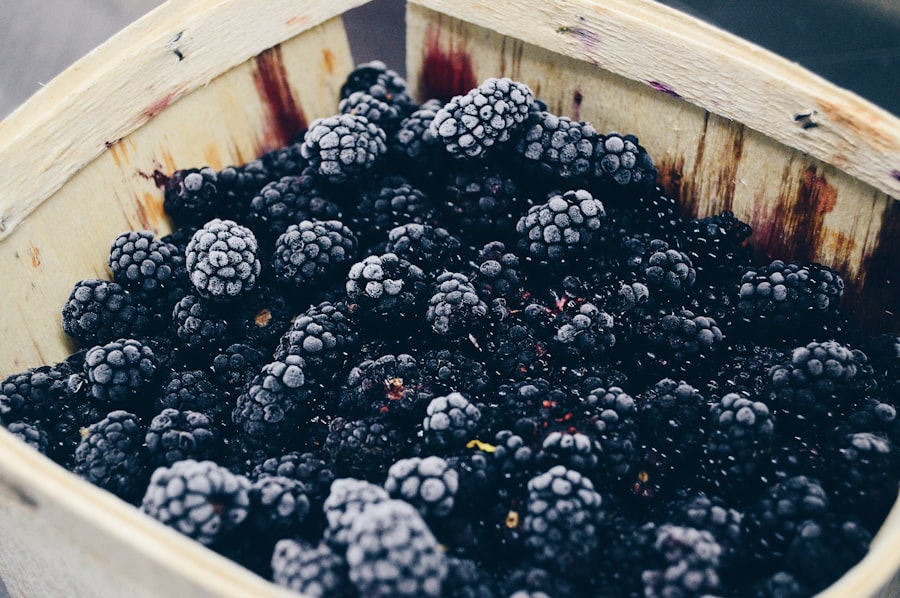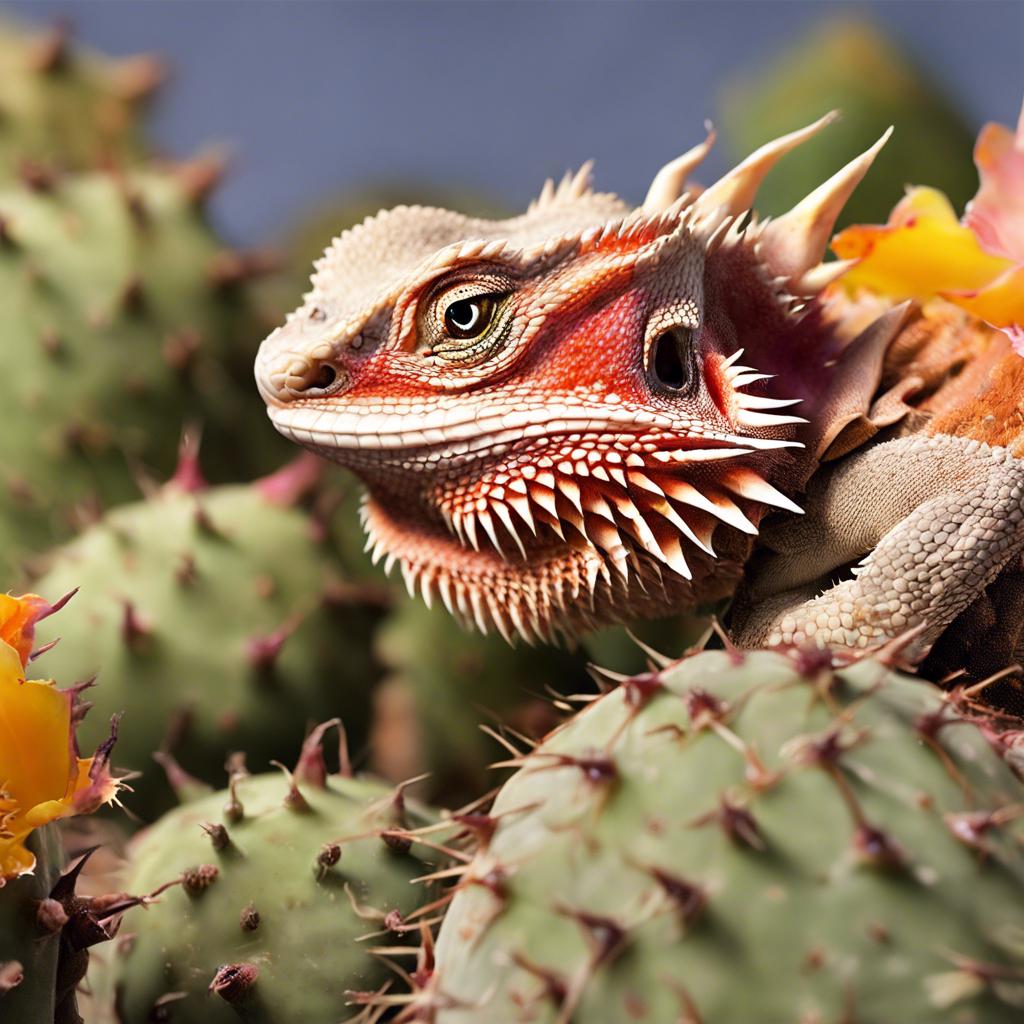Prickly pear fruit, also known as cactus fruit or nopales, is a popular food for bearded dragons. This fruit comes from the prickly pear cactus, which is native to the Americas. It is characterized by its vibrant colors and unique shape, with a thick outer skin covered in spines. The flesh of the fruit is sweet and juicy, making it a tasty treat for both humans and reptiles.
Bearded dragons are omnivorous reptiles that require a balanced diet to thrive. While their main diet consists of insects and leafy greens, adding fruits like prickly pear can provide them with additional nutrients and variety. Prickly pear fruit is rich in vitamins, minerals, and antioxidants that can benefit the overall health of bearded dragons.
Key Takeaways
- Prickly pear fruit is a nutritious food option for bearded dragons.
- Feeding prickly pear fruit to bearded dragons requires careful preparation and monitoring.
- Prickly pear fruit can provide benefits such as hydration and fiber for bearded dragons.
- Risks of feeding prickly pear fruit to bearded dragons include potential allergic reactions and overfeeding.
- Maintaining a balanced diet, monitoring food intake, and providing variety are important aspects of bearded dragon care.
Nutritional Value of Prickly Pear Fruit for Bearded Dragons
Prickly pear fruit is packed with essential nutrients that can contribute to a healthy diet for bearded dragons. Some of the key nutrients found in this fruit include vitamin C, vitamin A, calcium, potassium, and dietary fiber.
Vitamin C is important for the immune system and can help prevent diseases in bearded dragons. Vitamin A is essential for maintaining healthy skin and eyesight. Calcium is crucial for bone health and preventing metabolic bone disease, a common condition in reptiles. Potassium helps regulate fluid balance and muscle function. Dietary fiber aids in digestion and can prevent constipation.
Including prickly pear fruit in a bearded dragon's diet can provide these important nutrients and contribute to their overall well-being.
How to Feed Prickly Pear Fruit to Bearded Dragons
Feeding prickly pear fruit to bearded dragons requires some preparation to ensure that it is safe and easy for them to eat. Here is a step-by-step guide on how to prepare this fruit for your reptile companion:
1. Choose ripe fruit: Look for prickly pear fruit that is firm but slightly soft to the touch. Avoid fruits that are overly ripe or have moldy spots.
2. Remove spines: Use gloves or tongs to handle the fruit and remove the spines. You can also use a knife to carefully cut off the spines.
3. Peel the skin: Cut off both ends of the fruit and make a lengthwise incision along the skin. Gently peel off the skin, being careful not to remove too much flesh.
4. Cut into small pieces: Slice the fruit into small, bite-sized pieces that are easy for your bearded dragon to eat.
5. Serve to your bearded dragon: Place the prepared prickly pear fruit in your bearded dragon's feeding dish. Make sure to remove any uneaten fruit after a few hours to prevent spoilage.
It is important to note that while bearded dragons can eat prickly pear fruit, they should not consume the seeds or spines. These parts can be a choking hazard or cause digestive issues. Always remove these parts before serving the fruit to your reptile companion.
Benefits of Prickly Pear Fruit for Bearded Dragons
Feeding prickly pear fruit to bearded dragons can offer several benefits for their health and well-being. Some of these benefits include:
1. Hydration: Prickly pear fruit has a high water content, which can help keep bearded dragons hydrated, especially during hot weather or when they are shedding their skin.
2. Antioxidants: The antioxidants found in prickly pear fruit can help protect bearded dragons from oxidative stress and reduce the risk of certain diseases.
3. Vitamin C boost: Bearded dragons cannot produce vitamin C on their own, so it is important to provide them with dietary sources of this vitamin. Prickly pear fruit is an excellent source of vitamin C, which can support their immune system and overall health.
4. Variety in diet: Adding prickly pear fruit to a bearded dragon's diet can provide them with variety and prevent boredom. Offering a diverse range of foods can also help ensure that they are getting all the nutrients they need.
Potential Risks of Feeding Prickly Pear Fruit to Bearded Dragons
While prickly pear fruit can be a nutritious addition to a bearded dragon's diet, there are some potential risks to be aware of. These risks include:
1. Choking hazard: The seeds of prickly pear fruit can be a choking hazard for bearded dragons. Always remove the seeds before serving the fruit to your reptile companion.
2. Digestive issues: Bearded dragons have sensitive digestive systems, and consuming too much prickly pear fruit or eating it too quickly can lead to digestive issues such as diarrhea or bloating. It is important to monitor your bearded dragon's intake and serve the fruit in moderation.
3. Allergic reactions: Some bearded dragons may have allergic reactions to prickly pear fruit. Signs of an allergic reaction can include swelling, redness, or difficulty breathing. If you notice any of these symptoms, discontinue feeding prickly pear fruit and consult a veterinarian.
To minimize these risks, it is important to serve prickly pear fruit in moderation and monitor your bearded dragon's response to the fruit. If you have any concerns or notice any adverse reactions, consult a veterinarian for guidance.
Bearded Dragon Care: Maintaining a Balanced Diet

Feeding a balanced diet is crucial for the overall health and well-being of bearded dragons. While prickly pear fruit can provide some beneficial nutrients, it should not be the sole component of their diet. It is important to offer a variety of foods to ensure that they are getting all the nutrients they need.
A balanced diet for bearded dragons should consist of:
1. Insects: Bearded dragons are insectivores and require a variety of insects in their diet. Some suitable options include crickets, mealworms, and dubia roaches. Insects should be gut-loaded, meaning they are fed a nutritious diet before being fed to your bearded dragon.
2. Leafy greens: Bearded dragons also require a variety of leafy greens in their diet. Some suitable options include collard greens, mustard greens, and dandelion greens. These greens should be fresh and washed thoroughly before serving.
3. Vegetables and fruits: In addition to leafy greens, bearded dragons can also consume a variety of vegetables and fruits. Prickly pear fruit can be included as part of this category, but it should not be the main component of their diet.
Bearded Dragon Care: Monitoring Food Intake
Monitoring food intake is important to ensure that bearded dragons are not overeating or under-eating. Overfeeding can lead to obesity and other health issues, while under-eating can result in malnutrition.
To monitor food intake:
1. Offer appropriate portion sizes: Bearded dragons should be fed an appropriate portion size based on their age and size. Consult a veterinarian or reptile specialist for guidance on portion sizes.
2. Observe eating habits: Pay attention to how much your bearded dragon is eating during each feeding session. If they consistently leave food uneaten, it may indicate that they are not interested in that particular food or that they are not feeling well.
3. Adjust feeding schedule: Bearded dragons have different feeding requirements at different stages of their life. Adjust their feeding schedule accordingly to ensure that they are getting the right amount of food.
Bearded Dragon Care: Providing Variety in Diet
Providing variety in a bearded dragon's diet is important for several reasons. It can prevent boredom, ensure that they are getting all the necessary nutrients, and encourage a healthy appetite.
To provide variety in a bearded dragon's diet:
1. Rotate foods: Offer a variety of insects, leafy greens, vegetables, and fruits on a rotating basis. This will prevent your bearded dragon from getting bored with their food and ensure that they are getting a diverse range of nutrients.
2. Introduce new foods gradually: When introducing new foods to your bearded dragon, do so gradually to allow their digestive system to adjust. Start with small amounts and monitor their response before increasing the quantity.
3. Offer different textures: Bearded dragons have different preferences when it comes to food textures. Some may prefer crunchy insects, while others may enjoy softer fruits or vegetables. Offer a mix of textures to cater to their individual preferences.
Health Issues: Overfeeding and Obesity in Bearded Dragons
Overfeeding can lead to obesity in bearded dragons, which can have serious health consequences. Obesity can put strain on their organs, joints, and overall well-being.
To prevent overfeeding and obesity:
1. Follow portion guidelines: Feed your bearded dragon an appropriate portion size based on their age and size. Avoid overfeeding or offering excessive treats.
2. Monitor weight: Regularly weigh your bearded dragon to track their weight and body condition. If you notice significant weight gain, consult a veterinarian for guidance on adjusting their diet.
3. Provide regular exercise: Bearded dragons require regular exercise to maintain a healthy weight. Provide them with ample space to move around and engage in physical activity.
Health Issues: Possible Allergic Reactions to Prickly Pear Fruit in Bearded Dragons
While allergic reactions to prickly pear fruit are rare in bearded dragons, they can occur in some individuals. Signs of an allergic reaction can include swelling, redness, or difficulty breathing.
If you suspect that your bearded dragon is having an allergic reaction to prickly pear fruit, take the following steps:
1. Remove the fruit: Immediately remove the prickly pear fruit from your bearded dragon's enclosure.
2. Observe symptoms: Monitor your bearded dragon for any signs of distress or worsening symptoms. If the symptoms worsen or if you notice any difficulty breathing, seek immediate veterinary care.
3. Consult a veterinarian: If you suspect an allergic reaction, consult a veterinarian for guidance on how to manage the symptoms and prevent future reactions.
Prickly pear fruit can be a nutritious addition to a bearded dragon's diet, providing them with essential vitamins, minerals, and antioxidants. However, it is important to serve this fruit in moderation and monitor your bearded dragon's response to ensure their safety and well-being. Maintaining a balanced diet, monitoring food intake, and providing variety are key aspects of bearded dragon care. By following these guidelines and consulting a veterinarian when needed, you can help ensure that your bearded dragon remains healthy and happy.
If you're wondering whether bearded dragons can eat prickly pear fruit, you'll find all the answers in this informative article from Reptile Wizard. They provide valuable insights into the dietary needs of bearded dragons and discuss the safety and benefits of feeding them prickly pear fruit. To learn more about this topic, check out their article here. While you're at it, don't forget to explore Reptile Wizard's website for more reptile-related information, including their privacy policy here and disclaimer here.
FAQs
What is prickly pear fruit?
Prickly pear fruit is a type of cactus fruit that is commonly found in North and South America. It is also known as cactus pear, Indian fig, or tuna fruit.
Can bearded dragons eat prickly pear fruit?
Yes, bearded dragons can eat prickly pear fruit. It is a safe and nutritious addition to their diet.
What are the nutritional benefits of prickly pear fruit for bearded dragons?
Prickly pear fruit is rich in vitamins and minerals, including vitamin C, vitamin B6, magnesium, and potassium. It also contains antioxidants and fiber, which can help promote digestive health.
How should prickly pear fruit be prepared for bearded dragons?
Prickly pear fruit should be washed and peeled before feeding it to bearded dragons. The seeds should also be removed, as they can be a choking hazard.
Can bearded dragons eat prickly pear cactus pads?
Yes, bearded dragons can also eat prickly pear cactus pads. However, they should be washed and the spines should be removed before feeding them to your pet.

